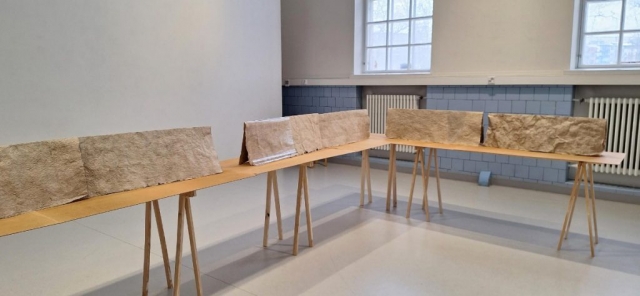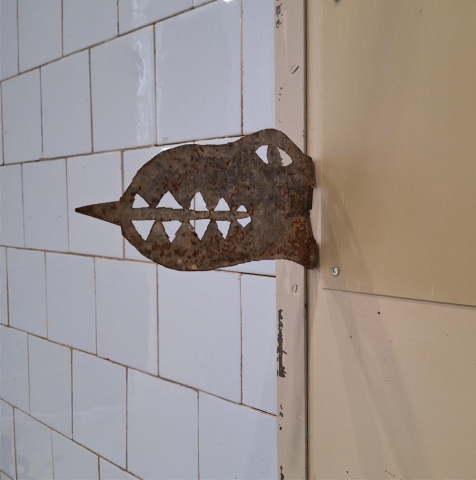Sittemmin
Teos esittää pienoismallia, suunnittelun ja rakentamisen apuvälinettä. Sen avulla otetaan askel ideasta toteutukseen. Suunnittelua ohjaavat nykyhetkestä käsin hahmottuvat tarpeet, vallitseva ymmärrys siitä, millainen maailma on ja miten siellä kannattaa toimia. Joskus nämä käsitykset periytyvät hyvinkin kaukaa, jopa monien sukupolvien takaa. Suunnittelu ja rakentaminen uusintavat nykyisiä ja vanhoja käsityksiä, kuljettavat niitä tulevaisuuteen.
Galleria Mältinranta toimii entisen vedenpuhdistuslaitoksen tiloissa. Rakennus on suunniteltu 1920-luvun lopussa ja pystytetty seuraavan vuosikymmenen alussa. Alaräihä on ripustanut gallerian nurkassa sijaitsevan mittarikaapin yhteyteen saman aikakauden esineistöä. Harava, saha ja tuuliviiri – tai oikeastaan niiden jäänteet – ovat peräisin pohjoispohjanmaalaiselta maatilalta, josta hän on kotoisin. Ne ovat olleet hänen esivanhempiensa käytössä.
Pienoismallin muotokieli toistaa esineistön kolmioaiheita. Mutta siinä missä haravan piikit, peltihirviön hampaat ja muut esineiden terävät kolmiot voi kokea epämääräisellä tavalla väkivaltaisiksi ja uhkaaviksi, pienoismallista tämä piirre puuttuu. Pikemmin se näyttäisi esittävän jonkinlaista suojaa.
Henri Laukkanen
Päivikki Alaräihän (s. 1981, Jakkukylä) työ ammentaa muun muassa minimalismin ja paikkasidonnaisen maalauksen perinteistä. Hänen näyttelyilleen on tyypillistä teosten ja esityspaikan vahva yhteys. Teokset muodostavat keskenään rinnastusten ketjuja, jotka kutsuvat vertailemaan eroja ja yhtäläisyyksiä. Esille nousee vivahteita ja näkökulmia, joita ei välttämättä muuten tulisi huomanneeksi. Sama viittaamisen tekniikka sitoo teoksia ja esityspaikkaa toisiinsa. Parhaimmillaan koko kokemus ympäröivästä tilasta muuttuu. Teokset ovat usein pelkistettyjä. Riisuttu muotokieli jättää katsojalle tilaa tarkkailla havainnossa ilmeneviä näkökulman vaihdoksia ja muutoksia – liikettä, joka on ominaista vertailujen kautta etenevälle ajattelulle. Lisäksi Alaräihän työskentelyä luonnehtii voimakas kiinnostus teoksissa käytettäviä materiaaleja kohtaan. Pintarakenteiden karheuksien, pigmenttien ominaisuuksien ja muiden sellaisten asioiden huomioiminen on oleellinen osa teoksia.
SINCE THEN
The installation represents a scale model – a tool which helps to transition from ideas to their actualization. Planning is informed by current needs and prevailing conceptions of what the world is like and how to operate in it. Sometimes the conceptions are handed down from very far away, even many generations ago, and by planning and constructing one reproduces them, carrying them into the future.
Gallery Mältinranta is located in the former water treatment plant. The building was designed in the late 1920’s and erected at the beginning of the following decade. Alaräihä has gathered artefacts from the same period and installed them on the switchboard in the gallery’s corner. The rake, saw and weathervane – or rather their remnants – are from the Northern Ostrobothnian farm where Alaräihä was born. Once they were used by her ancestors.
Triangular shapes of the artefacts are reproduced in the scale mode. But whereas their sharp triangles – such as, the spikes of the rake and the teeth of the tin monster – give me a vaguely violent or threatening impression, this is not the case with the scale model. Rather, the scale model appears to be a plan for a protective structure of some kind.
The artistic practice of Päivikki Alaräihä (b. 1981, Jakkukylä) draws on the traditions of minimalism and site-specific painting, among others. Typically, the works are binded together with chains of parallels. The connections invite the audience to pay attention to all kinds of small details – differences and similarities which give rise to perceptions and perspectives that otherwise remain easily unnoticed. Often, the chains of parallels tie the works and their exhibition places together too, transforming experience of the surrounding space. Alaräihä’s works are often rather minimalistic. Their stripped-down appearance leaves room for the viewers to observe what is going on in their perceptions as they interact with the works. Shifts in the perspectives become discernible. Also, Alaräihä’s practice is defined by strong interest in the materials that she uses. Attention to roughness of surface textures, the properties of pigments and other such material features characterises her works. Attention to the roughness of surface textures, the properties of pigments and other material attributes are characteristic of her work.




